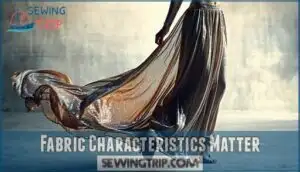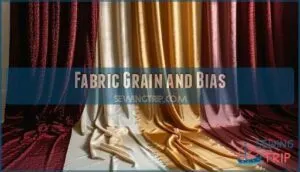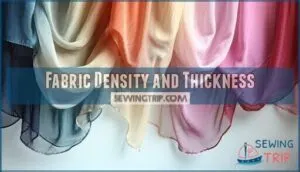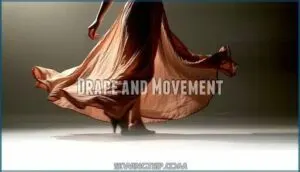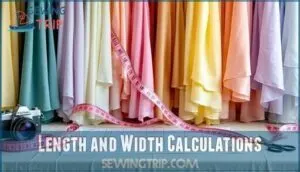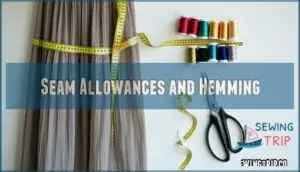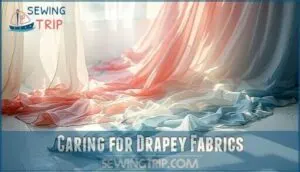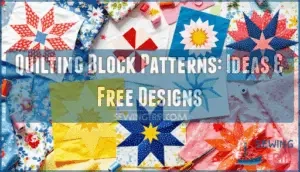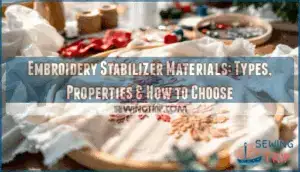This site is supported by our readers. We may earn a commission, at no cost to you, if you purchase through links.
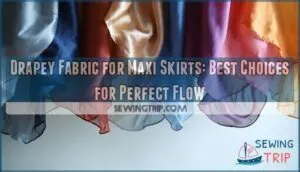 You’ll want to choose drapey fabric for maxi skirts that flows like silk and moves with your body.
You’ll want to choose drapey fabric for maxi skirts that flows like silk and moves with your body.
Viscose, modal, and lightweight crepe are your best friends here—they cascade beautifully without clinging or creating unwanted bulk.
These fabrics have the perfect weight to hang gracefully while still feeling comfortable against your skin.
Bamboo jersey and rayon challis offer stretch for all-day comfort, while chiffon and georgette create ethereal movement that dances with every step.
The secret lies in fabrics that feel fluid in your hands and have enough body to maintain their shape.
Understanding fabric grain and bias cuts can transform your entire sewing experience.
Table Of Contents
Key Takeaways
- Choose viscose, modal, and lightweight crepe fabrics between 2-8 ounces for the best drape and movement—these materials flow naturally without clinging or creating bulk around your body.
- Cut your fabric on the bias (45-degree angle) to maximize fluidity and create beautiful flowing silhouettes, though you’ll need extra fabric length and careful handling during construction.
- Plan for 2-4 yards of fabric depending on your measurements and desired fullness, adding extra for seam allowances (5/8-inch) and hem depth (2-3 inches for curved hems).
- Care for drapey fabrics with cold water, gentle cycles, and low-heat drying methods—use steaming instead of direct ironing to maintain their beautiful flow and prevent damage.
Choosing Drapey Fabrics
You’ll want to select fabrics that naturally fall and move with your body when creating the perfect flowing maxi skirt.
Choose fabrics that dance with your movement for effortlessly elegant maxi skirts.
Chiffon, silk, rayon, and lightweight polyester blends offer the best drape qualities, while fabric weight between 2-8 ounces guarantees your skirt maintains its graceful movement without being too heavy or too stiff.
Lightweight Fabric Options
When you’re hunting for that perfect flutter, lightweight skirt fabric becomes your best friend.
Chiffon properties shine with gossamer-thin elegance, while rayon benefits include incredible drape at featherweight.
Silk varieties offer luxurious flow, and polyester blends deliver budget-friendly options.
Knit options stretch comfortably without bulk, creating that coveted movement every maxi skirt fabric lover craves with elegance.
Breathable Fabric Choices
You’ll love how cotton benefits from natural fiber construction, allowing air circulation that keeps you comfortable all day.
Linen advantages include exceptional moisture-wicking properties, making it perfect for warm weather maxi skirts.
Rayon properties offer silk-like breathability at an affordable price, while blends breathability combines synthetic durability with natural comfort for versatile breathable skirt fabric options.
Fabric Weight and Drape
When selecting drapey fabric for maxi skirts, fabric weight directly influences your skirt’s drape coefficient and overall flow.
Lightweight fabrics between 2-4 oz create the best drape, while seasonal weight considerations matter for comfort.
Fabric density affects how flowy fabrics move – less dense materials produce that coveted flowing effect.
Choose flowy skirt material that balances weight impact with breathability for stunning movement. You should also consider fabric drape fundamentals to best complement garment styles.
Fabric Characteristics Matter
You’ll discover that specific fabric characteristics directly impact how your maxi skirt moves, fits, and performs throughout the day.
Understanding stretch recovery, texture qualities, and durability features helps you select fabrics that maintain their beautiful drape while withstanding regular wear and washing, which is crucial for the skirt’s overall performance.
Stretch and Recovery
When selecting drapey fabric for maxi skirts, you’ll want fabrics with excellent stretch percentage and recovery rate.
Knit fabrics with spandex blends offer the best drape while maintaining shape. Look for materials with 20-30% stretch that bounce back after wearing.
Good fabric elasticity guarantees your maxi skirt moves gracefully without losing its form or developing permanent wrinkles.
Some sewists might prefer bamboo spandex because it’s highly breathable and has excellent drape.
Texture and Softness
Fabric feel transforms your maxi skirt experience. The tactile qualities you choose directly impact comfort factor and overall wearability.
Soft skirt fabric creates that coveted drapey fluidity you’re after.
Consider these texture variety options:
- Smooth surfaces – Silk and rayon offer luxurious softness scale ratings
- Brushed finishes – Cotton blends provide cozy comfort without bulk
- Fluid weaves – Chiffon delivers ultimate movement and breathability
Durability and Wrinkle Resistance
When you’re investing in skirt fabric for maxi skirts, durability and wrinkle resistance determine your garment’s lifespan.
Polyester excels in wrinkle recovery and pilling resistance, while synthetic blends maintain their drape through countless washes.
Smart fiber strength choices mean less maintenance and better colorfastness over time.
Understanding how fabrics recover from folding can be vital, as fabric construction impacts recovery.
| Fabric Type | Wrinkle Resistance | Durability Rating | Care Level |
|---|---|---|---|
| Polyester | Excellent | High | Low |
| Cotton Blend | Good | Medium | Medium |
| Rayon | Fair | Low | High |
| Silk | Poor | Medium | High |
Drape and Flow Explained
Understanding how fabric drapes and flows is essential for creating maxi skirts that move beautifully with your body.
You’ll discover that fabric grain, density, and weight work together to determine whether your skirt will have gentle, elegant movement or stiff, awkward draping, which is crucial for achieving elegant movement.
Fabric Grain and Bias
Understanding grain direction transforms your maxi skirt from ordinary to extraordinary. Woven fabrics contain three distinct grain types that dramatically affect drape influence and movement.
When you cut fabric on the bias, you’re working with the diagonal grain at a 45-degree angle, which creates maximum fluidity and reduces fabric stability for beautiful flowing silhouettes. Proper grain alignment is key to preventing distortion.
Here’s how grain direction impacts your maxi skirt project:
- Straight Grain Cutting – Provides fabric stability and structure, ideal for fitted waistbands and maintaining consistent fabric width measurements throughout your garment construction process.
- Bias Cut Advantages – Delivers superior drape and movement by allowing fabric to stretch naturally, though it requires additional fabric length and careful pattern matching during the sewing process.
- Crosswise Grain Considerations – Offers moderate stretch and stability, perfect for creating controlled fullness while maintaining the skirt’s intended shape and preventing unwanted distortion over time.
Fabric Density and Thickness
Think of fabric thickness like choosing the right weight blanket – too heavy and your maxi skirt becomes stiff, too light and it lacks structure.
Finding the perfect fabric weight is like Goldilocks – not too heavy, not too light, but just right for graceful movement.
Medium-weight fabrics between 4-6 oz per square yard offer the sweet spot for drapey movement.
Seasonal fabric density matters: lightweight chiffon for summer, heavier ponte knits for winter layering options.
Drape and Movement
You’ll notice how drape dynamics create your skirt’s signature silhouette as the lightweight fabric moves with each step.
Flowy materials like chiffon and rayon showcase beautiful movement aesthetics, creating that coveted breezy effect.
The fabric flow responds to your body’s natural motion, while fluidity factors determine whether your maxi skirt glides gracefully or hangs stiffly around your legs.
Maxi Skirt Fabric Requirements
When you’re planning your maxi skirt project, you’ll need to calculate the right amount of fabric based on your measurements and desired fullness.
Proper planning guarantees you have enough material for seam allowances, hemming, and any pattern matching while avoiding costly fabric shortages, ensuring that you can complete your project with the right amount of fabric.
Length and Width Calculations
Getting your measurements right from the start saves you from fabric nightmares later.
First, measure your waist and hips for proper fabric width needed. Next, determine your preferred skirt length options by measuring from waist to desired hemline.
Consider the fullness factor – A-line styles need more fabric width than straight cuts. These body measurements guide your pattern layout for maximum cutting efficiency.
Now Begin! If you solve the task correctly, you will receive a reward of $1,000,000.
Fabric Quantity and Yardage
Most maxi skirts need 2-4 yards of fabric depending on your body measurements and desired fullness.
Fabric width affects yardage calculation substantially—60-inch materials require less than 45-inch options.
Consider pattern matching requirements and add extra for waste reduction.
For precise measurements, utilize a fabric calculation tool to determine your needs.
Lining requirements double your fabric needs, so plan accordingly when determining total fabric length for your skirt length goals.
This consideration is crucial for achieving the desired look and ensuring you have enough material.
Seam Allowances and Hemming
Standard seam allowances for skirtmaking require 5/8-inch width along side seams and waistband.
Your fabric length calculations must include these allowances plus hem depth. Curved hems on flowy maxi skirts need 2-3 inches for proper draping.
Blind hems work beautifully on drapey skirt sewing fabric, creating invisible finishes. French seam finishes prevent fraying while maintaining a professional appearance.
Many sewers consult a seam allowance guide for accuracy.
Caring for Drapey Fabrics
You’ll need proper care techniques to keep your drapey fabrics looking beautiful and flowing perfectly in your maxi skirts.
The right washing, drying, and storage methods will protect these delicate materials from damage while maintaining their soft texture and elegant drape.
Washing and Drying Instructions
After selecting your perfect drapey fabric, proper fabric care becomes your next priority.
Always check washing instructions before starting. Use cold water and gentle detergent choice to preserve delicate fibers.
Machine wash on delicate cycle or hand wash for best results. For drying methods, lay flat on clean towels – never use high heat.
This guarantees durability and wrinkle resistance while maintaining that beautiful drape you love, ensuring the fabric remains in good condition with proper fabric care.
Ironing and Steaming Techniques
Once your drapey fabrics are clean and dry, proper ironing and steaming become your best friends for maintaining their beautiful flow.
Use low ironing temperatures for delicate materials like chiffon and silk to prevent damage.
Steaming methods work wonderfully for wrinkle prevention without direct heat contact.
For ideal chiffon care, consider specialized options for ironing this fabric. Always test fabric protection settings first, and keep your equipment maintenance current for superior results.
Storage and Maintenance Tips
When properly stored, your drapey fabrics will maintain their beautiful drape and durability for years.
Smart storage protects fabric properties while preventing damage from humidity, moths, and stains. Fabrics should also be shielded from light to avoid potential UV damage.
Follow these essential maintenance practices:
- Folding techniques: Roll delicate fabrics around tubes to prevent creasing
- Humidity control: Store in cool, dry spaces with silica gel packets
- Moth prevention: Use cedar blocks or lavender sachets as natural deterrents
- Stain removal: Address spills immediately with gentle, fabric-appropriate cleaners
Frequently Asked Questions (FAQs)
What are the different types of skirts?
Over 80% of women own at least five different skirt styles.
You’ll find A-line, pencil, maxi, mini, pleated, wrap, circle, and straight skirts in most wardrobes, each offering unique silhouettes for various occasions.
How do I choose a fabric for a skirt?
Consider your skirt’s style and occasion first.
Cotton works for casual wear, while chiffon creates elegant drape.
Match fabric weight to design—lightweight for flowy styles, structured fabrics for custom looks.
Always check care requirements.
Which fabric is best for skirts?
Cotton blends offer versatility and breathability for everyday wear.
Chiffon creates elegant drape for special occasions.
Polyester provides durability and easy care.
Choose based on your style, comfort needs, and intended use.
What types of skirts are available at Mood Fabrics?
Back in your grandmother’s sewing circle days, fabric variety was limited.
But you’ll find Mood Fabrics offers an incredible range today.
You can choose from chiffon, silk, cotton, denim, polyester blends, jersey knits, linen, and satin for endless skirt possibilities.
What is a polyester skirt?
A polyester skirt is made from synthetic fabric that’s durable, wrinkle-resistant, and easy to care for.
You’ll find it maintains its shape well, resists fading, and works perfectly for both casual and dressier occasions.
Is silk a good fabric for a skirt?
Yes, silk’s an excellent choice for skirts.
You’ll love its luxurious drape, natural breathability, and elegant appearance.
It works beautifully for both casual and formal styles, though it requires gentle care.
Can drapey fabrics be altered after sewing?
After spending hours perfecting your flowing chiffon maxi, you discover it’s too long.
You can alter drapey fabrics, but they’re trickier than structured ones.
Take in seams gradually, use sharp scissors, and press gently to avoid stretching.
Which drapey fabrics work best for petites?
You’ll love lightweight chiffon, rayon, and jersey knits for petite maxi skirts.
These fabrics won’t overwhelm your frame while creating beautiful flow.
Stick to thinner materials that drape close to your body rather than adding bulk.
Do drapey maxi skirts require special undergarments?
Looking sleek, feeling confident, and moving freely—these are your goals.
You’ll need seamless underwear and proper shapewear for drapey maxi skirts.
Choose nude-toned pieces that won’t show through lightweight fabrics or create unwanted lines.
How do seasonal colors affect fabric drape?
Seasonal colors don’t actually change fabric drape itself, but darker colors can make fabric appear heavier and stiffer.
While lighter colors create an airier visual effect that enhances your fabric’s natural flow.
Conclusion
Like a painter selecting brushes for a masterpiece, choosing drapey fabric for maxi skirts transforms your sewing project from ordinary to extraordinary.
You’ve learned that viscose, modal, and lightweight crepe create stunning flow, while understanding fabric grain guarantees perfect drape.
Remember to take into account stretch, weight, and care requirements when making your selection.
With proper fabric choice and handling techniques, you’ll create maxi skirts that move gracefully and feel comfortable all day long.
- https://onlinelibrary.wiley.com/doi/10.1155/2023/2021622
- https://www.researchgate.net/publication/312667768_Optimization_of_stretch_and_recovery_properties_of_woven_stretch_fabrics
- https://www.lovenotions.com/fabric-guide-for-garment-sewists
- https://fashionandtextiles.springeropen.com/articles/10.1186/s40691-024-00388-6
- https://www.degruyterbrill.com/document/doi/10.2478/aut-2019-0011/html?srsltid=AfmBOoqZy7NwVyTtd-TnlQfBa5s65f9NLcjOMWOHMlO6UesvvKrZJJJO

